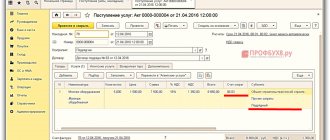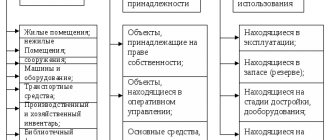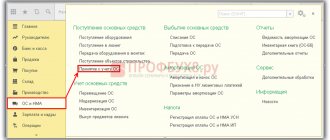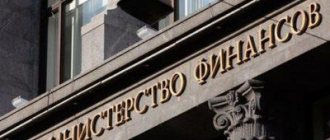Changes in accounting for fixed assets in 2021 are associated with the introduction of the new All-Russian Classifier of Fixed Assets OK 013-2014 (SNA 2008). The Decree of the Government of the Russian Federation dated 01.01.2002 No. 1, which approved the Classification of fixed assets for tax accounting purposes, was also amended (Regulation of the Government of the Russian Federation dated 07.07.2016 No. 640). In some cases, the amendments will affect the determination of the useful life of newly acquired property.
Let us remind you that for tax accounting purposes, from January 1, 2021, property with a useful life of more than 12 months and an original cost of more than 100,000 rubles is considered depreciable. The new limit applies to property put into operation from 2021. In accounting, the same limit remained - 40,000 rubles.
Depreciable property is distributed among depreciation groups in accordance with its useful life (SPI) (clause 1 of Article 258 of the Tax Code of the Russian Federation).
From January 1, 2021, organizations will determine depreciation groups and depreciation periods for fixed assets according to the new Classifier of fixed assets OK 013-2014 (SNS 2008) (approved by order of Rosstandart dated December 12, 2014 No. 2018-st).
The old Classifier of fixed assets OK 013-94, which determined one of the ten groups of depreciable property, will be cancelled.
In the new Classifier of Fixed Assets, the codes of fixed assets objects have completely changed: their numbering has changed. The names of objects have also partially changed. In this regard, changes were made to the Decree of the Government of the Russian Federation (Regulation of the Government of the Russian Federation dated 01.01.2002 No. 1 (hereinafter referred to as Resolution No. 1)), which approved the Classification of fixed assets for tax accounting purposes (Regulation of the Government of the Russian Federation dated 07.07.2016 No. 640). These changes also come into force on January 1, 2021.
How to determine the useful life of a non-residential building
Depreciation group is a group of depreciable property objects (fixed assets and intangible assets), formed on the basis of useful lives. The main purpose of a depreciation group is to determine the useful life of an object.
Depreciation groups of buildings and structures
They are close to those for accounting, but still different. The useful life is the period during which an item of fixed assets or an item of intangible assets serves to fulfill the goals of the taxpayer's activities. The useful life is determined by the taxpayer independently on the date of commissioning of this depreciable property item.
Buildings and structures are groups of fixed assets that are usually characterized by the longest useful lives (USL). We’ll tell you how to set this deadline and what to follow in doing so in our consultation.
General rules for accounting
There are general rules that an accountant must follow when calculating depreciation of non-residential premises and non-residential buildings. These include:
- accruals occur monthly in the amount of 1/12 of the amount calculated for the current year;
- during the SPI, depreciation accrual is not suspended;
- accrual stops from the first day of the following month after the amount of the cost of the fixed asset has been fully repaid or it has been removed from the company’s books.
Everything is described in detail in instructions No. 157 N.
Useful life of buildings and structures
- the expected life of the facility in accordance with expected productivity or capacity;
- expected physical wear and tear, depending on the operating mode, natural conditions and the influence of an aggressive environment, and the repair system;
- regulatory and other restrictions on the use of the facility.
Depreciation of buildings and structures in tax accounting: SPI
In tax accounting when establishing the useful life of fixed assets, incl. buildings and structures, you must refer to the Classification of fixed assets included in depreciation groups (Government Decree No. 1 of 01.01.2002, clause 1 of Article 258 of the Tax Code of the Russian Federation). In it, buildings and structures, depending on their type, are classified into III – X depreciation groups.
The eighth depreciation group (useful life over 20 years and up to 25 years) includes “Buildings (except residential)” - “Frameless buildings with lightweight masonry walls, reinforced concrete, brick and wooden columns and pillars, with reinforced concrete, wooden and other floors ; wooden buildings with cobblestone or chopped log walls; bunded structures" (OKOF code 210.00.00.00.000).
The seventh depreciation group (useful life over 15 years and up to 20 years) includes “Buildings (except residential)” - “Wooden, frame and panel, container, wood-metal, frame-cladding and panel, adobe, adobe, adobe and other similar "(OKOF code 210.00.00.00.000).
Rationale
The ninth depreciation group (useful life over 25 years and up to 30 years) includes “Buildings (except residential)” - “Vegetable and fruit storage facilities with stone walls, reinforced concrete or brick columns, reinforced concrete coverings” (OKOF code 210.00.00.00.000 ).
At the same time, the new owner will have the difficult task of determining the useful life of this object, and this period cannot be less than 30 years. Turning for reference to the resolution of the Council of Ministers of the USSR of October 22, 1990 N 1072 “On uniform standards of depreciation charges for the complete restoration of fixed assets of the national economy of the USSR”, we find that for such buildings (more than two floors high, not having special capital characteristics, that is, classified code 10001), the standard service life was set at 100 years (1% depreciation per year). However, on the basis of which documents an enterprise can accept a specific useful life of the acquired premises from a period of 30 to 100 years, the Tax Code of the Russian Federation does not establish.
We recommend reading: Minimum tariff rate in 2021 amount
Display in the balance sheet
By law, depreciation must be charged to the credit of account 02 (depreciation of fixed assets).
By debit, depreciation can be reflected on account 25 - general production or account 26 - general economic calculations. It all depends on the specific purpose of use. For example, account 25 records workshops and other premises that take part in production. Account 26 contains offices and premises for managers.
If the OS is used to create a new OS, then its depreciation will be charged to line 1190 of non-current assets. In the balance sheet, depreciation is taken into account in line 2350 of other expenses or in the line of commercial expenses if the premises are regularly rented out.
| Debit | Credit | Operation |
| 20,23 | 02 | Depreciation has been calculated for fixed assets that are involved in production. |
| 25 | 02 | Depreciation of fixed assets that are used for general production needs. |
| 26 | 02 | Depreciation of fixed assets for general business needs. |
| 44 | 02 | Depreciation of fixed assets that are involved in trading. |
| 02 | 01 | The process of writing off accumulated depreciation on a retired asset. |
| 83 | 02 | Increasing the amount of depreciation when revaluing non-residential premises. |
| 02 | 91/1 | Reducing the amount when depreciating a non-residential building. |
Depreciation helps reduce losses for company owners and shareholders due to the obsolescence and unusability of a non-residential property. It is important to take into account the useful life, as well as the cost of the premises. The SPI can be calculated independently or refer to a special Classifier, where, depending on the material and design of the building, its SPI is indicated.
Which depreciation group does non-residential premises belong to?
The only indication that can be relied upon in this case is paragraph 5 of Article 258, according to which the enterprise is allowed to be guided by “technical conditions and recommendations of manufacturing organizations.” Although, strictly speaking, this provision is provided for those types of fixed assets that are not indicated in depreciation groups, it is still not given otherwise. Consequently, if the documents received in the process of preparing for state registration (for example, an extract from the BTI technical passport) contain an indication of the standard service life of the building in which the purchased premises are located, then this should be chosen as the useful life. If there is no such data in the documents, then for this information, in our opinion, you should contact an independent expert working in the field of real estate valuation, or a construction organization constructing similar buildings. Suppose that, using one of the listed methods, the enterprise has determined that the building, which includes the purchased property, is expected to be useful for 50 years. However, this is not enough to correctly calculate the depreciation rate.
Additionally
At the same time, the legislation does not prohibit an organization, when establishing the SPI of buildings and structures, to be guided by the Classification of fixed assets included in depreciation groups used in tax accounting. If an organization systematically uses the Tax Classification when determining private investment income in accounting, it is advisable to consolidate this procedure in the Accounting Policy for accounting purposes. In addition, the establishment of a single SPI for buildings and structures in accounting and tax accounting will help reduce the differences between the two accounting systems.
Until January 1, 2021, the All-Russian Classifier of Fixed Assets OK 013-94 is in force, approved by Decree of the State Standard of Russia dated December 26, 1994 N 359 (hereinafter referred to as OK 013-94), according to which premises built into buildings and intended for shops, canteens, hairdressing salons , studios, rental points for cultural and household items and household items, kindergartens, nurseries, post offices, banks and other organizations whose purpose is different from the main purpose of the building are included in the main building. Despite the fact that this clarification concerned the subsection “Buildings (except residential)”, we believe that this can also be attributed to the subsection “Dwellings”.
Application of the Fixed Asset Classifier when changing the SPI
As a general rule, the SPI is revised when there is an improvement in the initially established standard indicators of the functioning of the facility as a result of completion, additional equipment, reconstruction, or modernization.
Let us recall that in tax accounting, an increase in SPI can only be made within the time limits established for the depreciation group in which the fixed asset was previously included. If the useful life after reconstruction, modernization or technical re-equipment has been increased, the organization has the right to charge depreciation at a new rate, calculated based on the new useful life of the fixed asset (letter of the Ministry of Finance of Russia dated 08/04/2016 No. 03-03-06/1 /45862). But such a recalculation of the depreciation rate will lead to the fact that the object will depreciate longer, so for the organization in this case it is more profitable to charge depreciation according to the previous rates.
If, after modernization (reconstruction), the initial cost of the object has changed, but the SPI remains the same, then the depreciation rate when using the linear method in tax accounting cannot be revised, and at the end of the SPI, the fixed asset will not be fully depreciated. However, according to the explanations of the Ministry of Finance of Russia, organizations in this case are allowed to continue to charge depreciation using the straight-line method until the cost of the fixed asset is fully repaid and after the end of the joint venture, if it was not revised after the modernization (reconstruction) of the fixed asset (letter of the Ministry of Finance of Russia dated July 5, 2011 No. 03-03- 06/1/402, dated 09/10/2009 No. 03-03-06/2/167, dated 02/12/2009 No. 03-03-06/1/57).
When, after modernization (reconstruction), the technical characteristics of an object have changed so much that it begins to comply with the new OKOF code (old and new codes will have to be analyzed in 2021), the object should be considered as a new fixed asset. In this case, its initial cost and SPI will need to be determined again, using a new Classifier.
And in accounting, SPI is an estimated value. Therefore, the organization has the opportunity, without taking into account any standards, to change (clarify) the SPI in cases such as, for example, modernization or reconstruction, reflecting such adjustments in accounting and reporting. At the same time, the possibility of revising the SPI as an estimated value must be fixed in the accounting policies of the organization.
Depreciation period for non-residential premises
Let's continue using the example data. Non-residential premises, the ownership of which has not yet transferred to the enterprise (until the moment of its state registration), for accounting purposes as of January 1, 2002, is listed on the capital investment account. However, for tax purposes, in accordance with paragraph 8 of Article 258, fixed assets “are included in the corresponding depreciation group from the moment of documented fact of filing documents for registration of these rights.” Therefore, an enterprise must calculate depreciation deductions for premises and include them in tax expenses (according to the new rules) from January 1, 2002, regardless of the date on which its ownership of this property will be entered into the Unified State Register.
We recommend reading: Sample of filling out Appendix No. 4 for cargo transfer
To which depreciation group can non-residential premises be classified for the purpose of calculating income tax?
At the same time, the new owner will have the difficult task of determining the useful life of this object, and this period cannot be less than 30 years. Turning for reference to the resolution of the Council of Ministers of the USSR of October 22, 1990 N 1072 “On uniform standards of depreciation charges for the complete restoration of fixed assets of the national economy of the USSR”, we find that for such buildings (more than two floors high, not having special capital characteristics, that is, classified code 10001), the standard service life was set at 100 years (1% depreciation per year). However, on the basis of which documents an enterprise can accept a specific useful life of the acquired premises from a period of 30 to 100 years, the Tax Code of the Russian Federation does not establish.
Let's continue using the example data. Non-residential premises, the ownership of which has not yet transferred to the enterprise (until the moment of its state registration), for accounting purposes as of January 1, 2002, is listed on the capital investment account. However, for tax purposes, in accordance with paragraph 8 of Article 258, fixed assets “are included in the corresponding depreciation group from the moment of documented fact of filing documents for registration of these rights.” Therefore, an enterprise must calculate depreciation deductions for premises and include them in tax expenses (according to the new rules) from January 1, 2002, regardless of the date on which its ownership of this property will be entered into the Unified State Register.
What are depreciation charges?
These are monthly transfers of the value of non-residential real estate in parts in monetary terms to a special account, which is called “depreciation”. According to Art. 259 of the Tax Code of the Russian Federation, these deductions must be made by all organizations, taking into account the book value of real estate, which is their property. There are some buildings to which this law does not apply, since they are simply mothballed.
Any room wears out and becomes obsolete physically and morally as it is used.
Depreciation has the following purposes:
- use the transferred funds to improve existing or purchase new real estate as necessary;
- distribute large expenses in parts over periods, on an accrual basis;
- investors get the impression that the company does not have large expenses and losses, since at the end of its service life there will not be a huge figure in the report for write-off of the facility, which will seem like a loss-making amount for investors;
- payment of income tax is reduced.
All this helps reduce the owner’s losses on maintenance and subsequent write-off of the non-residential property.
Which depreciation group does non-residential premises belong to?
- the expected life of the facility in accordance with expected productivity or capacity;
- expected physical wear and tear, depending on the operating mode, natural conditions and the influence of an aggressive environment, and the repair system;
- regulatory and other restrictions on the use of the facility.
Useful life of buildings and structures
The seventh depreciation group (useful life over 15 years and up to 20 years) includes “Buildings (except residential)” - “Wooden, frame and panel, container, wood-metal, frame-cladding and panel, adobe, adobe, adobe and other similar "(OKOF code 210.00.00.00.000).
The seventh depreciation group (useful life over 15 years and up to 20 years) includes “Buildings (except residential)” - “Wooden, frame and panel, container, wood-metal, frame-cladding and panel, adobe, adobe, adobe and other similar "(OKOF code 210.00.00.00.000).
What OKOF code should I use to register a printer?
This opinion is expressed by employees of the tax inspectorate, and this fact has been repeatedly confirmed in Russian judicial practice (for example, ]]gt; Resolution of the AS of the West Siberian District dated December 9, 2021 No. Ф04-5705/2021]]gt;). In this case, the taxpayer evaluates office equipment by individual functions, and based on this, the maximum depreciation period is selected.
IMPORTANT. There are objects that are not in the OS classifier. The company must then determine the useful life based on the manufacturer's recommendations or specifications. This is stated in paragraph 6 of Article 258 of the Tax Code of the Russian Federation.
OKOF code (version until 01/01/2021) 14 3020000 - Electronic computing equipment, including personal computers and printing devices for them; servers of various performance; network equipment of local computer networks; data storage systems; modems for local networks; modems for backbone networks.
The Tax Code clearly requires owners of fixed assets to correctly distribute them among depreciation groups in accordance with the approved Classifier approved by Decree of the Government of the Russian Federation No. 1 of 01/01/2002.
It is impossible to imagine a modern office without a computer. The cost of modern PCs of various modifications can reach the marginal cost of classifying an object as fixed assets, and, therefore, such office equipment is depreciated.
OKOF code for computers is 330.28.23.23, which corresponds to depreciation group 2, with a useful life of more than 2 years, up to 3 years inclusive. The organization has the right to independently determine a specific period based on the specified range of values. This group also includes:
- Stationary PC;
- laptop;
- monoblock
All named devices are ready-made working complexes and are accounted for as a single inventory object.
Multifunctional office devices and MFPs are not mentioned in the classifier, so you will have to determine their service life (UF) yourself.
Most experts recommend using the third depreciation group, which mentions OKOF 330.28.23.22 “Copying machines... for offices.” At the same time, there is OKOF 330.28.23.23, which we discussed above. It belongs to the second group of depreciation and includes, among other things, printers as components of a PC.
Since the MFP, in addition to printing functions, is used as a fax machine, a copy machine, etc., it is advisable to collectively use the maximum depreciation group - the third, the SPI for which is 3-5 years.
It is possible to correlate the MFP with OKOF 320.26.20.15, which characterizes machines containing (or not containing) one or more of the named devices in a single shell: storage, input or output devices.
The printer and scanner can be classified into the second depreciation group. The basis is OKOF 330.28.23.23, which includes not only the computer itself, but also the printing equipment for it. In addition, if the laser printer is equipped with a processor, then OKOF 320.26.20.13 is applicable to it. SPI for the 2-3 year group. These devices are taken into account as separate depreciation objects only if they are not part of the “computer” object.
A shredder, or paper shredder, is also recommended to be included in the 2nd depreciation group.
An organization providing services may have a cash register as part of its office equipment and use it for settlements with clients. Such a device is accounted for by the sum of all costs for its acquisition and, depending on the final cost, acquires the status of a fixed asset or is written off as an expense as inventory.
A cash register can be accounted for under code 330.28.23.13 “Counting machines, cash registers... and other similar machines.” They belong to the fourth depreciation group, SPI 5-7 years.
Standard accounting entries for office equipment look like this:
- Dt 08 Kt 60 – the cost of office equipment and software settings for it is fixed.
- Dt 01 Kt 08 – equipment put into operation.
- Dt 20(26.44) Kt 02 – depreciation has been accrued (from the month following commissioning).
As noted above, in the vast majority of cases, for both NU and BU, it is advisable to use the linear method of calculating depreciation.
- Depreciation of office equipment is carried out according to the general rules for calculating depreciation charges, in accordance with the standards of the OS classifier currently in force and OKOF codes.
- For office equipment not mentioned in the classifier, the maximum depreciation group is selected according to the number of device elements included in it.
- For some types of office equipment, it is possible to use different OKOF options.
- It is recommended to account for a computer as a single depreciation object, which includes all its components.
As a general rule, to determine the depreciation group, first find the fixed asset in OKOF and find out which code corresponds to it. Then find this code in the Classification and determine which depreciation group it belongs to.
All accountants are required to include OKOF 2021 codes in their accounting documents - from the current version of the All-Russian Classifier of Fixed Assets. It was adopted and introduced for application by order of Rosstandart dated December 12, 2021 No. 2021-st. Its official abbreviated name is OK 013-2021 (SNA 2021).
On January 1, 2021, a new classifier of fixed assets came into force, it is also known as OKOF-2. Accordingly, new coding for fixed assets should be used, while the old classifiers continue to be valid. For quick translation, the OKOF-2 converter is used. At the same time, the new version also lacks the concept of a multifunctional device, and difficulties arise with coding the equipment.
To register an MFI on its balance sheet, the tax regulator recommends using one of the options of the third depreciation group. The device is evaluated as a whole and individually, so that the maximum amount of depreciation is selected as a result.
The current legislation provides a clear definition of property recognized as depreciable. Prerequisites for the calculation of depreciation are that the object is owned by the company, as well as its participation in activities that generate economic income. The monitor, considered as a separate item, cannot meet this condition, since it is not able to bring profit to the enterprise. And only as part of a complex, combined with a processor, keyboard and having general control, can it be recognized as an inventory object. Let us recall that each position in such a complex of objects cannot function independently.
Note that a computer is a complex of structurally connected objects ready for operation. Therefore, a laptop (depreciation group 2), as well as a desktop computer that can immediately after purchase be included in the production process and begin generating income for the company, when registered, is subject to the same useful life of 2 to 3 years.





